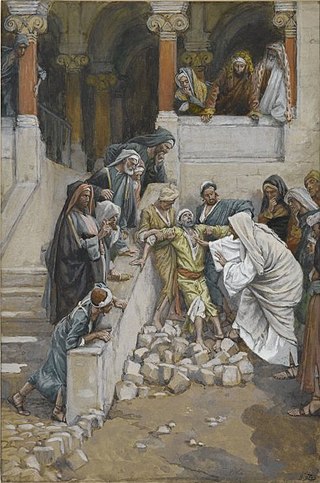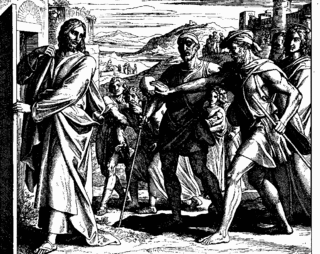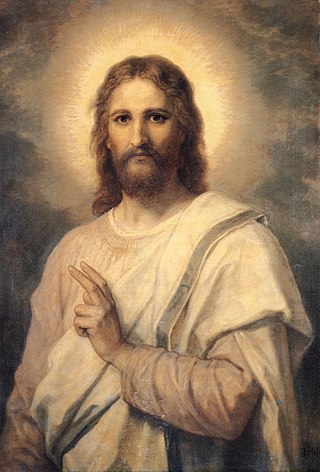
The miracles of Jesus are the many miraculous deeds attributed to Jesus in Christian texts, with the majority of these miracles being faith healings, exorcisms, resurrections, and control over nature.

Matthew 9 is the ninth chapter of the Gospel of Matthew in the New Testament. It continues the narrative about Jesus' ministry in Galilee as he ministers to the public, working miracles, and going through all the cities and towns of the area, preaching the gospel, and healing every disease. This chapter opens with Jesus back in "his own town", i.e. Capernaum. This chapter reflects "the crucial role of faith" in relation to healing.
Matthew 12:38 is the 38th verse in the twelfth chapter of the Gospel of Matthew in the New Testament.
Matthew 9:33 is a verse in the ninth chapter of the Gospel of Matthew in the New Testament.
Matthew 9:34 is a verse in the ninth chapter of the Gospel of Matthew in the New Testament.
Matthew 9:32 is a verse in the ninth chapter of the Gospel of Matthew in the New Testament.

Matthew 12:13 is the thirteenth verse in the twelfth chapter of the Gospel of Matthew in the New Testament.
Matthew 12:22 is the 22nd verse in the twelfth chapter of the Gospel of Matthew in the New Testament.
Matthew 12:26 is the 26th verse in the twelfth chapter of the Gospel of Matthew in the New Testament.
Matthew 12:27 is the 27th verse in the twelfth chapter of the Gospel of Matthew in the New Testament.

Jesus heals a man with a withered hand on the Sabbath in one of his miracles recounted in the Gospels, namely in Matthew 12:9-13, Mark 3:1-6, and Luke 6:6-11.

The exorcism of a boy possessed by a demon, or a boy with a mute spirit, is one of the miracles attributed to Jesus reported in the synoptic Gospels, involving the healing of a demonically possessed boy through exorcism. It is in all Synoptic Gospels: Mark 9:17-29, Matthew 17:14-21, Luke 9:40-44. In the Gospel narratives, this healing takes place following the Transfiguration.

Exorcising the blind and mute man is one of the miracles of Jesus in the Gospels. It appears in Matthew 12:22-32, Luke 11:14-23 and Mark 3:20-30.

Healing a man with dropsy is one of the miracles of Jesus in the Gospels.

The miracle of healing the man born blind is one of the miracles of Jesus in the Gospels, in which Jesus restored the sight of a man at Siloam. Although not named in the gospel, church tradition has ascribed the name Celidonius to the man who was healed. The account is recorded in the ninth chapter of the Gospel of John.

Jesus healing two blind men is a miracle attributed to Jesus in the Gospel of Matthew. It follows immediately on the account of the Daughter of Jairus.

The Calling of Matthew, also known as the Calling of Levi, is an episode in the life of Jesus which appears in all three synoptic gospels, Matthew 9:9–13, Mark 2:13–17 and Luke 5:27–28, and relates the initial encounter between Jesus and Matthew, the tax collector who became a disciple.

The following outline is provided as an overview of and topical guide to Wikipedia articles on the life and influence of Jesus.
Matthew 11:4-6 is a set of verses in the eleventh chapter of the Gospel of Matthew in the New Testament.
Matthew 15:29-31 is a set of verses in the fifteenth chapter of the Gospel of Matthew in the New Testament.











